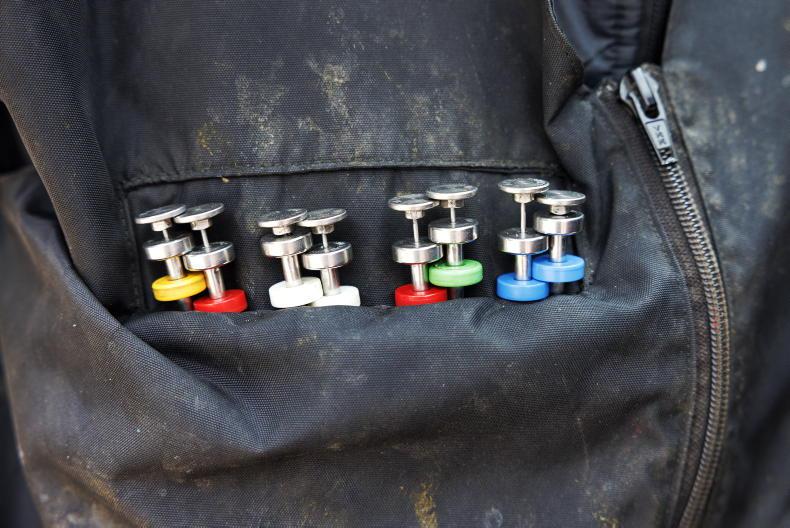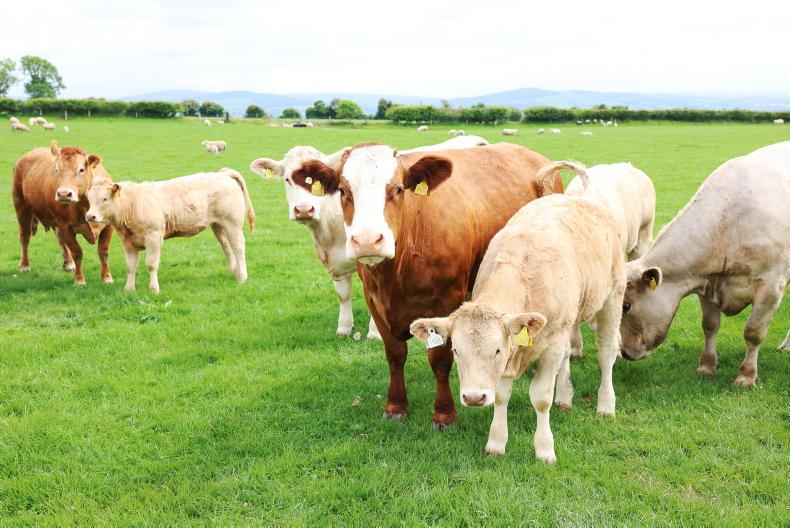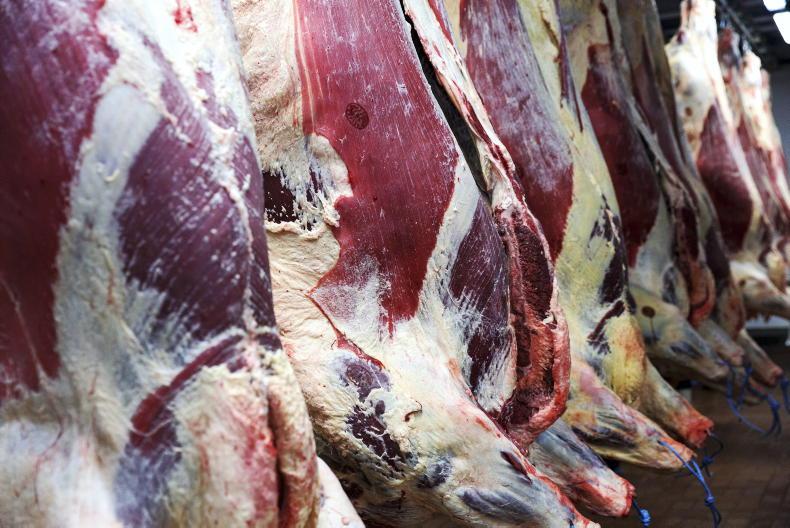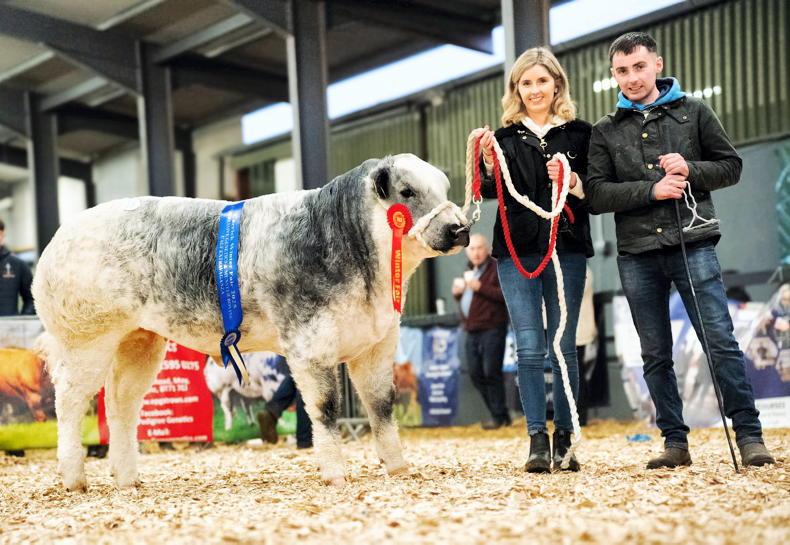The challenging weather conditions continue to cause disruption to turnout. Most suckler farmers run spring calving systems because getting a cow out to grass in spring lowers costs, along with spring grass being very important in increasing the nutrition plane of the cow. This has a huge effect on the resumption of cycling after calving.
With some cows still housed across the country this will impact getting cows back in calf, especially were poor quality silage and low levels of concentrates were fed.
Profitable suckler cows need to produce a calf every 365 days, or as close to this as possible. This is not easily achieved, but there are a number of suckler producers who do hit this target every year. The average calving interval for suckler cows in 2023 was 390 days.
A cow calving every 12 months produces a calf around the same time, in the same month for every year she is retained in the herd. A cow calving every year sounds ideal, but the animal may well be slipping back in calving date every year that she is retained in the herd. The average calving interval across all suckler cows in Ireland, according to ICBF, is 390 days, which means a cow is calving approximately every 13 months.
Achieving a 365-day calving interval
To get a cow calving every 365 days requires a high level of herd management. There is a very narrow window of opportunity to get the animal calved and re-bred. A cow’s production cycle can be broken into these three parts:
The gestation period when the cow is in calf.The anoestrus period occurs immediately after calving, when no cycling activity occurs.The oestrus period is when the cow has come back into heat and the cow is cycling.Early gestation
A suckler cow is in calf for approximately 280 to 290 days. During this period, management practices will influence herd fertility.
In the early weeks of gestation, the cow will be increasing milk production, which places additional energy requirement on the animal’s diet.
Body condition score (BCS) plays an important role right throughout the production year.
Increasing nutritional demand can lead to a change in cow condition. Cows should be served at a BCS of 2.5 to 3.0.
If there is not enough energy supplied in the diet, then the cow will start to mobilise her body reserves to make up the balance.
At all costs, avoid any loss of BCS in the six-week period after breeding to reduce the chance of embryonic loss.
Where cows are being bred in late June, grass will have headed out and therefore has a lower feed value.
Cows grazing this type of grass are at risk of not meeting their nutritional demand and, as a result, there is a higher risk of embryonic loss occurring.
Late gestation
Rapid weight loss in the final six weeks of pregnancy should be avoided as metabolic health issues can develop.
Spring-calving cows should calve at BCS 2.5. Calving in the correct BCS helps with calving ease and maintains milk production.
It also increases the viability of embryo production once the cow comes back in heat after calving. Feeding dry cow mineral for six weeks pre-calving is beneficial for cow fertility.
Anoestrus period
After calving, the cow has a period where there is no reproductive activity, known as the anoestrus period.
During this time, the cow is recovering from the stress of calving. This period can last from 30 days to 100 days, depending on body condition, health, diet and calving ease.
To achieve a 365-day calving interval, the anoestrus period needs to be around 30 to 40 days. Thin cows at calving and calving difficulties such as caesarean section can prolong this period to 60 to 100 days.
If the cow is in BCS 2.5 and moved from a silage diet to fresh grazing, the increase in energy supplied from grass can shorten the period.
Likewise, breaking the cow and calf bond by restricting the calf to suckling the cow twice daily will significantly shorten this period compared with unrestricted suckling.
Oestrus period
In a well-managed herd, a suckler cow will have the chance to cycle twice if a 365-day calving interval is to be achieved. Often in the first cycle, the duration of standing heat can be short, which makes heat detection difficult where AI is being used.
The stock bull, or teaser bull, can stimulate cows to display stronger heats. Timing of service is crucial if AI is being used.
Cows should be served around 12 to 15 hours after they were detected in heat for the best chance of conception.
Maintaining the cow on a steady high-energy diet throughout this period is important, as is minimising stress levels. Keeping the cow on a steady diet for a six-week period after breeding is also important to avoid embryonic death.
Other factors
Do not forget about the bull. Make sure the bull is working by monitoring closely to ensure he is mounting cows correctly.
Watch for repeats to detect any sign of infertility. Avoid carrying out routine management tasks like foot trimming immediately prior to the breeding period, and ensure the bull is in good condition before the season takes off.
Cow numbers should be limited to a maximum of 20 for a young bull and 35 for a mature, proven bull.
Having a high number of early-breeding cows means there may be too many cows coming into heat at once, so the cow numbers will have to be reduced for the bull to cover them all.
The challenging weather conditions continue to cause disruption to turnout. Most suckler farmers run spring calving systems because getting a cow out to grass in spring lowers costs, along with spring grass being very important in increasing the nutrition plane of the cow. This has a huge effect on the resumption of cycling after calving.
With some cows still housed across the country this will impact getting cows back in calf, especially were poor quality silage and low levels of concentrates were fed.
Profitable suckler cows need to produce a calf every 365 days, or as close to this as possible. This is not easily achieved, but there are a number of suckler producers who do hit this target every year. The average calving interval for suckler cows in 2023 was 390 days.
A cow calving every 12 months produces a calf around the same time, in the same month for every year she is retained in the herd. A cow calving every year sounds ideal, but the animal may well be slipping back in calving date every year that she is retained in the herd. The average calving interval across all suckler cows in Ireland, according to ICBF, is 390 days, which means a cow is calving approximately every 13 months.
Achieving a 365-day calving interval
To get a cow calving every 365 days requires a high level of herd management. There is a very narrow window of opportunity to get the animal calved and re-bred. A cow’s production cycle can be broken into these three parts:
The gestation period when the cow is in calf.The anoestrus period occurs immediately after calving, when no cycling activity occurs.The oestrus period is when the cow has come back into heat and the cow is cycling.Early gestation
A suckler cow is in calf for approximately 280 to 290 days. During this period, management practices will influence herd fertility.
In the early weeks of gestation, the cow will be increasing milk production, which places additional energy requirement on the animal’s diet.
Body condition score (BCS) plays an important role right throughout the production year.
Increasing nutritional demand can lead to a change in cow condition. Cows should be served at a BCS of 2.5 to 3.0.
If there is not enough energy supplied in the diet, then the cow will start to mobilise her body reserves to make up the balance.
At all costs, avoid any loss of BCS in the six-week period after breeding to reduce the chance of embryonic loss.
Where cows are being bred in late June, grass will have headed out and therefore has a lower feed value.
Cows grazing this type of grass are at risk of not meeting their nutritional demand and, as a result, there is a higher risk of embryonic loss occurring.
Late gestation
Rapid weight loss in the final six weeks of pregnancy should be avoided as metabolic health issues can develop.
Spring-calving cows should calve at BCS 2.5. Calving in the correct BCS helps with calving ease and maintains milk production.
It also increases the viability of embryo production once the cow comes back in heat after calving. Feeding dry cow mineral for six weeks pre-calving is beneficial for cow fertility.
Anoestrus period
After calving, the cow has a period where there is no reproductive activity, known as the anoestrus period.
During this time, the cow is recovering from the stress of calving. This period can last from 30 days to 100 days, depending on body condition, health, diet and calving ease.
To achieve a 365-day calving interval, the anoestrus period needs to be around 30 to 40 days. Thin cows at calving and calving difficulties such as caesarean section can prolong this period to 60 to 100 days.
If the cow is in BCS 2.5 and moved from a silage diet to fresh grazing, the increase in energy supplied from grass can shorten the period.
Likewise, breaking the cow and calf bond by restricting the calf to suckling the cow twice daily will significantly shorten this period compared with unrestricted suckling.
Oestrus period
In a well-managed herd, a suckler cow will have the chance to cycle twice if a 365-day calving interval is to be achieved. Often in the first cycle, the duration of standing heat can be short, which makes heat detection difficult where AI is being used.
The stock bull, or teaser bull, can stimulate cows to display stronger heats. Timing of service is crucial if AI is being used.
Cows should be served around 12 to 15 hours after they were detected in heat for the best chance of conception.
Maintaining the cow on a steady high-energy diet throughout this period is important, as is minimising stress levels. Keeping the cow on a steady diet for a six-week period after breeding is also important to avoid embryonic death.
Other factors
Do not forget about the bull. Make sure the bull is working by monitoring closely to ensure he is mounting cows correctly.
Watch for repeats to detect any sign of infertility. Avoid carrying out routine management tasks like foot trimming immediately prior to the breeding period, and ensure the bull is in good condition before the season takes off.
Cow numbers should be limited to a maximum of 20 for a young bull and 35 for a mature, proven bull.
Having a high number of early-breeding cows means there may be too many cows coming into heat at once, so the cow numbers will have to be reduced for the bull to cover them all.









SHARING OPTIONS